The University of Michigan-Shanghai Jiao Tong University Joint Institute (UM-SJTU JI, JI hereafter) 2023 Winter Design Expo opened on December 13 at Long Bin Building, displaying 37 innovative design projects from a number of autumn experimental courses of freshmen and senior students including “Introduction to Engineering”, “System Design and Implementation”, “Design and Manufacturing 3,” “Computer Architecture,” and “Product Design and Manufacturing”.
The exhibited projects featured a wide range of practical and cutting-edge solutions, from ping pong ball serving machines to guide cars, from smart irrigation systems to automatic blinds. This semi-annual design expo serves as a comprehensive display of JI students’ remarkable innovations.
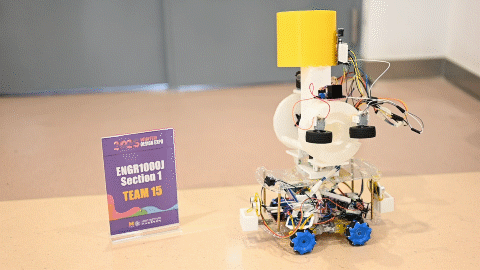
As a “national sport of China,” table tennis is widely popular not only in China but also around the world. However, as a group sport, enthusiasts of table tennis often find themselves constrained by the availability of playing partners or the challenge of finding someone willing to engage in high-intensity repetitive practice of a specific skill. Consequently, table tennis ball serving machines have emerged. However, existing serving machines are often fixed on the ground or table, limiting their ability to simulate the mobile and dynamic nature of a human opponent. Therefore, a team of JI freshman students have designed a table tennis ball serving vehicle that can move on the table. The design consists of two main parts: the launching mechanism and the vehicle. Most components of the launching mechanism are produced through 3D printing. The top container serves as a receptacle for table tennis balls, controlled by a servo motor to release the balls one by one. After following an arc-shaped track, the balls are propelled by two friction wheels through high-speed rotation. Two additional servo motors control the rotation direction and launch angle of the balls. The vehicle, equipped with four mecanum wheels, enables lateral movement. The vehicle operates in both fixed and random modes. Users can connect to it via Bluetooth on their smartphones, input a series of numbers to set the ball’s rotation, launch angle, and launch point. Alternatively, they can let the vehicle move randomly for more realistic simulation of actual gameplay scenarios.
 Automatic Pothole Filling (APF) Robot
People who frequently traverse city roads undoubtedly understand the importance of road conditions for safe driving and smooth traffic flow. However, the process from the appearance of potholes on the road to reporting, and eventually repairing, often takes a considerable amount of time. Roads that cannot be repaired promptly significantly increase safety hazards. Therefore, a JI team of freshman students have designed an Automatic Pothole Filling (APF) robot. This robot is equipped with material for filling potholes, and it automatically detects road conditions using ultrasonic sensors. It uses servo motors and a pressure plate to release and flatten the filling material promptly, thus repairing the road surface. Traditional pothole detection mainly relies on information reported by drivers, and these reports typically only cover obvious and larger potholes. If a fleet of APF automatic road repair robots were deployed on urban roads for detection and repair, all potholes could be filled within a few hours, ensuring that drivers can experience high-quality road conditions.
Automatic Pothole Filling (APF) Robot
People who frequently traverse city roads undoubtedly understand the importance of road conditions for safe driving and smooth traffic flow. However, the process from the appearance of potholes on the road to reporting, and eventually repairing, often takes a considerable amount of time. Roads that cannot be repaired promptly significantly increase safety hazards. Therefore, a JI team of freshman students have designed an Automatic Pothole Filling (APF) robot. This robot is equipped with material for filling potholes, and it automatically detects road conditions using ultrasonic sensors. It uses servo motors and a pressure plate to release and flatten the filling material promptly, thus repairing the road surface. Traditional pothole detection mainly relies on information reported by drivers, and these reports typically only cover obvious and larger potholes. If a fleet of APF automatic road repair robots were deployed on urban roads for detection and repair, all potholes could be filled within a few hours, ensuring that drivers can experience high-quality road conditions.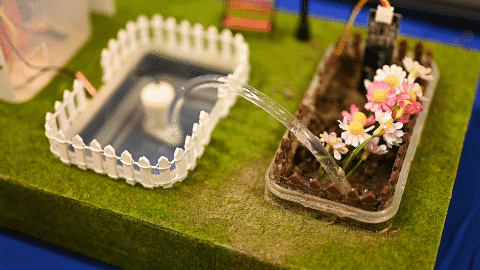 Smart Solar-Powered Plant Monitoring and Irrigation System
As an agricultural powerhouse, the development of agriculture is crucial for China’s economic progress. However, with the ongoing process of urbanization, rural areas are facing a shortage of labor. Therefore, more intelligent equipment that reduces labor demands is particularly important. A JI freshman student team has designed an Intelligent Solar-Powered Plant Monitoring and Irrigation System that can monitor the plant’s growth environment in real-time and irrigate it promptly. Moreover, it uses eco-friendly solar energy, helping to alleviate the burden on conventional energy sources. The student project comprises three main components: an intelligent monitoring system, smart irrigation equipment, and a solar charging module. The power section provides energy for the entire device. In this part, solar panels convert sunlight into electricity. The battery stores energy to activate the monitoring and irrigation processes when needed. For monitoring, soil-inserted humidity sensors and temperature sensors collect data regularly every hour. The collected data is sent for processing to a microcomputer, and a visual representation is generated on a website for user accessibility. Regarding irrigation, a Schmidt trigger directly controls the water pump based on the output voltage from the humidity sensor. Consequently, the humidity is automatically maintained within a range suitable for plant growth. This project enables users to track the plant’s growth status at any time through their smartphones and represents a new attempt towards achieving a fully automated smart farm.
Smart Solar-Powered Plant Monitoring and Irrigation System
As an agricultural powerhouse, the development of agriculture is crucial for China’s economic progress. However, with the ongoing process of urbanization, rural areas are facing a shortage of labor. Therefore, more intelligent equipment that reduces labor demands is particularly important. A JI freshman student team has designed an Intelligent Solar-Powered Plant Monitoring and Irrigation System that can monitor the plant’s growth environment in real-time and irrigate it promptly. Moreover, it uses eco-friendly solar energy, helping to alleviate the burden on conventional energy sources. The student project comprises three main components: an intelligent monitoring system, smart irrigation equipment, and a solar charging module. The power section provides energy for the entire device. In this part, solar panels convert sunlight into electricity. The battery stores energy to activate the monitoring and irrigation processes when needed. For monitoring, soil-inserted humidity sensors and temperature sensors collect data regularly every hour. The collected data is sent for processing to a microcomputer, and a visual representation is generated on a website for user accessibility. Regarding irrigation, a Schmidt trigger directly controls the water pump based on the output voltage from the humidity sensor. Consequently, the humidity is automatically maintained within a range suitable for plant growth. This project enables users to track the plant’s growth status at any time through their smartphones and represents a new attempt towards achieving a fully automated smart farm.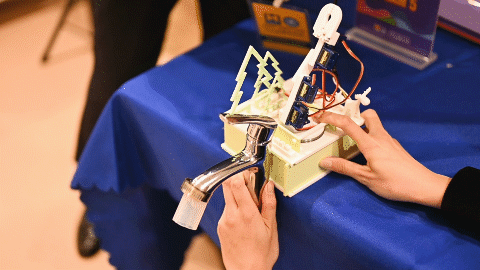 Water resources have always been one of the most crucial resources for humanity. However, many people have likely experienced instances of water wastage, such as overflowing bathtubs, due to absentmindedly leaving the water running. Existing alarm devices in the market typically trigger alerts only when water accumulates on the floor, leading to water wastage. On the other hand, sensor-based water shut-off systems can prevent excessive flow but often require someone to be present continuously, wasting time. Therefore, a team of freshman students have designed a device that can consistently dispense a specific volume of water and automatically shut off when reaching a certain water level. The device consists of two main components: the working component and the charging component. The working component addresses all requirements except for energy efficiency, while the charging component provides power. In the working component, the product incorporates an Arduino board, a buzzer, a robotic arm, and a flow meter. By using an integral approach to calculate the instantaneous flow rate, the total water volume is obtained. The buzzer is then triggered to alert the user when the water is in place, and the robotic arm is activated to turn off the faucet. For the charging component, the product utilizes eco-friendly solar energy. A transformer is employed to convert 6V to the appropriate charging voltage of 3.7V, significantly improving charging efficiency. The product is portable, flexible, reliable, cost-effective, and well-suited for travel.
Water resources have always been one of the most crucial resources for humanity. However, many people have likely experienced instances of water wastage, such as overflowing bathtubs, due to absentmindedly leaving the water running. Existing alarm devices in the market typically trigger alerts only when water accumulates on the floor, leading to water wastage. On the other hand, sensor-based water shut-off systems can prevent excessive flow but often require someone to be present continuously, wasting time. Therefore, a team of freshman students have designed a device that can consistently dispense a specific volume of water and automatically shut off when reaching a certain water level. The device consists of two main components: the working component and the charging component. The working component addresses all requirements except for energy efficiency, while the charging component provides power. In the working component, the product incorporates an Arduino board, a buzzer, a robotic arm, and a flow meter. By using an integral approach to calculate the instantaneous flow rate, the total water volume is obtained. The buzzer is then triggered to alert the user when the water is in place, and the robotic arm is activated to turn off the faucet. For the charging component, the product utilizes eco-friendly solar energy. A transformer is employed to convert 6V to the appropriate charging voltage of 3.7V, significantly improving charging efficiency. The product is portable, flexible, reliable, cost-effective, and well-suited for travel.
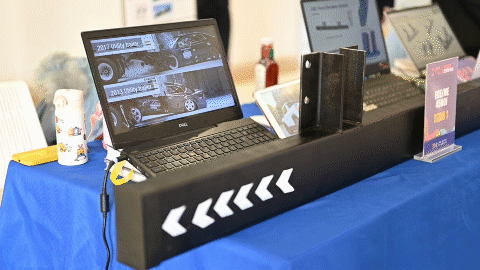 Simulation for Rear Underrun Protection
To address the issue of personal injuries and property damage resulting from rear-end collisions in traffic accidents, a team of senior students focused on enhancing vehicle safety features through the design of a rear lower protection device. The goal is to prevent smaller vehicles from sliding underneath larger vehicles during collisions, reducing the likelihood of tragic accidents and promoting road traffic safety. Their project emphasizes the urgency and importance of the design of the rear lower protection device. By designing the rear lower protection device for N2 vehicles, a prototype was manufactured and subjected to computer-aided engineering (CAE) simulations to validate the reliability of the design. Through innovative design and technological implementation at the rear of the vehicle, the project aims to significantly reduce casualties and losses resulting from rear-end collisions. The investigation also delved into existing design elements related to the objectives and specifications, considering customer requirements and material properties in the process.
Simulation for Rear Underrun Protection
To address the issue of personal injuries and property damage resulting from rear-end collisions in traffic accidents, a team of senior students focused on enhancing vehicle safety features through the design of a rear lower protection device. The goal is to prevent smaller vehicles from sliding underneath larger vehicles during collisions, reducing the likelihood of tragic accidents and promoting road traffic safety. Their project emphasizes the urgency and importance of the design of the rear lower protection device. By designing the rear lower protection device for N2 vehicles, a prototype was manufactured and subjected to computer-aided engineering (CAE) simulations to validate the reliability of the design. Through innovative design and technological implementation at the rear of the vehicle, the project aims to significantly reduce casualties and losses resulting from rear-end collisions. The investigation also delved into existing design elements related to the objectives and specifications, considering customer requirements and material properties in the process.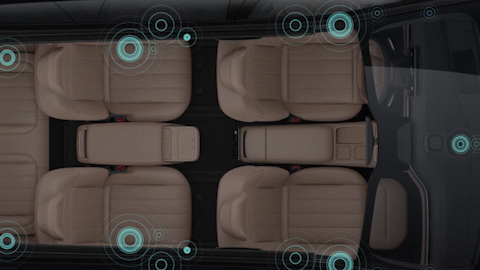 Automation of Vehicle Trim Noise Detection
In the complex environment of production lines, achieving interior noise and squeak detection is a highly challenging task. a JI student team set their aim to develop an integrated embedded device capable of automatically detecting interior squeaks in vehicles with high precision and rapid detection speed. Additionally, the device is designed to be highly versatile, enabling further commercialization and application on inspection lines in different automotive factories. The system achieves full-process automation of sound collection, signal processing, result display, and data uploading through the integration of hardware and software. On the hardware side, the system is based on the Ubuntu 20.04 Linux system and designed as an embedded system on the Raspberry Pi 4B. It integrates various peripherals, including a circular microphone array, display, and keyboard. A custom-designed casing connects all hardware components into a complete and portable product. On the software side, automation for recording and data preprocessing is implemented using scripts and Python. For door panel resonance squeak detection, the system uses Short-Time Fourier Transform to convert the data into a spectrogram and applies Mel-Scale filter banks to amplify differences. For seat adjustment squeak detection, Gaussian model regression is employed to identify differences between normal and abnormal seats in the time domain. Both processes involve multi-channel validation during the analysis.
Automation of Vehicle Trim Noise Detection
In the complex environment of production lines, achieving interior noise and squeak detection is a highly challenging task. a JI student team set their aim to develop an integrated embedded device capable of automatically detecting interior squeaks in vehicles with high precision and rapid detection speed. Additionally, the device is designed to be highly versatile, enabling further commercialization and application on inspection lines in different automotive factories. The system achieves full-process automation of sound collection, signal processing, result display, and data uploading through the integration of hardware and software. On the hardware side, the system is based on the Ubuntu 20.04 Linux system and designed as an embedded system on the Raspberry Pi 4B. It integrates various peripherals, including a circular microphone array, display, and keyboard. A custom-designed casing connects all hardware components into a complete and portable product. On the software side, automation for recording and data preprocessing is implemented using scripts and Python. For door panel resonance squeak detection, the system uses Short-Time Fourier Transform to convert the data into a spectrogram and applies Mel-Scale filter banks to amplify differences. For seat adjustment squeak detection, Gaussian model regression is employed to identify differences between normal and abnormal seats in the time domain. Both processes involve multi-channel validation during the analysis.
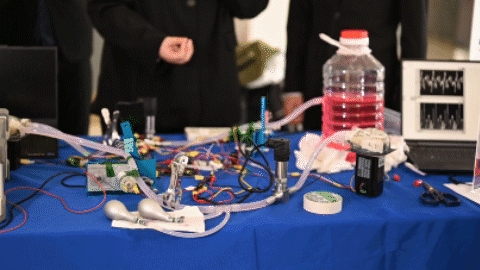 Human Circulatory System Simulation Benchmark Testing Platform
In addition to the automotive industry, JI students apply engineering knowledge to various fields, including healthcare. A team of senior students put their focus on developing a benchmark testing platform for simulating the human circulatory system, aiming to accurately replicate the complex dynamics of the human circulatory system. The system exhibits various transient behaviors and disturbances, making it a challenging subject for research and simulation. The platform is designed to provide an adjustable model of the heart and blood vessels for in-depth study and analysis. This includes the ability to observe and measure specific parameters such as pressure and flow in different parts of the system, which is crucial for understanding the mechanisms of the circulatory system and the development of medical devices. The purpose of this project goes beyond simulation; its goal is to create an accessible and adaptable tool. The system will be designed for ease of modification, allowing researchers to simulate different scenarios and disturbances, such as variations in heart chamber and valve behavior. This adaptability is crucial for exploring the relationships between different components of the circulatory system under normal and pathological conditions. The platform serves as a valuable resource for understanding how the circulatory system responds to various stimuli, which is essential for the design and testing of new medical devices.
Human Circulatory System Simulation Benchmark Testing Platform
In addition to the automotive industry, JI students apply engineering knowledge to various fields, including healthcare. A team of senior students put their focus on developing a benchmark testing platform for simulating the human circulatory system, aiming to accurately replicate the complex dynamics of the human circulatory system. The system exhibits various transient behaviors and disturbances, making it a challenging subject for research and simulation. The platform is designed to provide an adjustable model of the heart and blood vessels for in-depth study and analysis. This includes the ability to observe and measure specific parameters such as pressure and flow in different parts of the system, which is crucial for understanding the mechanisms of the circulatory system and the development of medical devices. The purpose of this project goes beyond simulation; its goal is to create an accessible and adaptable tool. The system will be designed for ease of modification, allowing researchers to simulate different scenarios and disturbances, such as variations in heart chamber and valve behavior. This adaptability is crucial for exploring the relationships between different components of the circulatory system under normal and pathological conditions. The platform serves as a valuable resource for understanding how the circulatory system responds to various stimuli, which is essential for the design and testing of new medical devices.
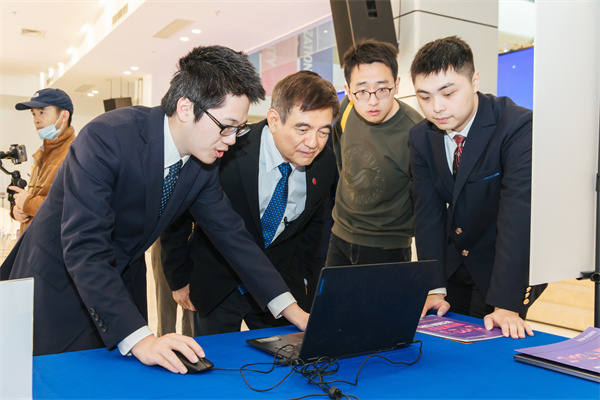
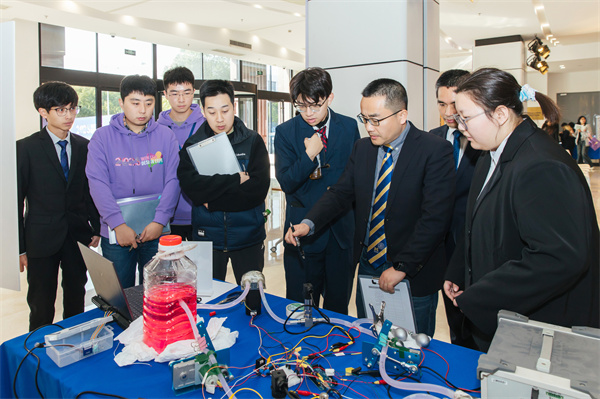

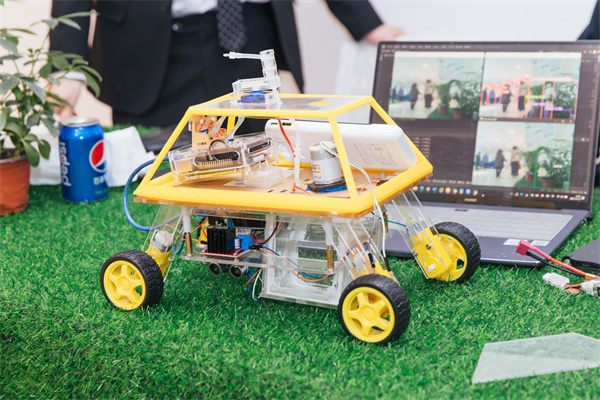

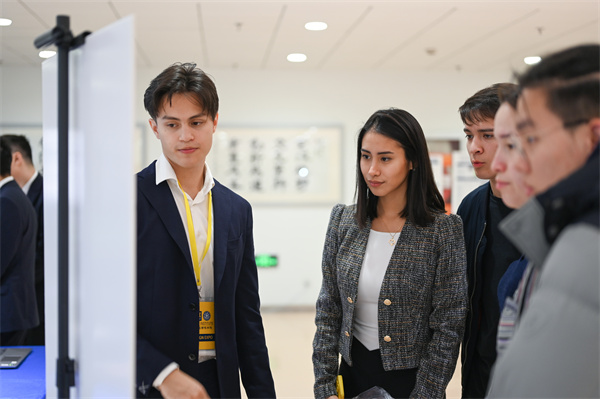
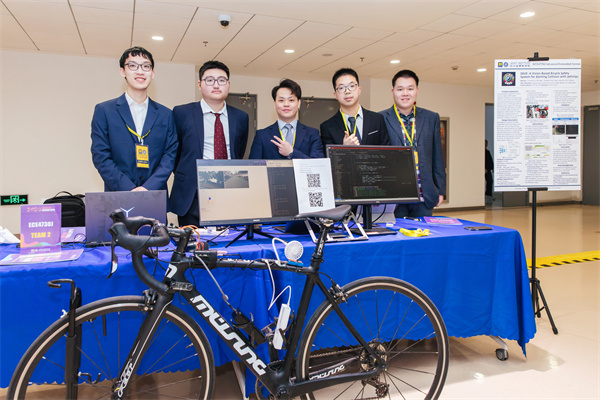
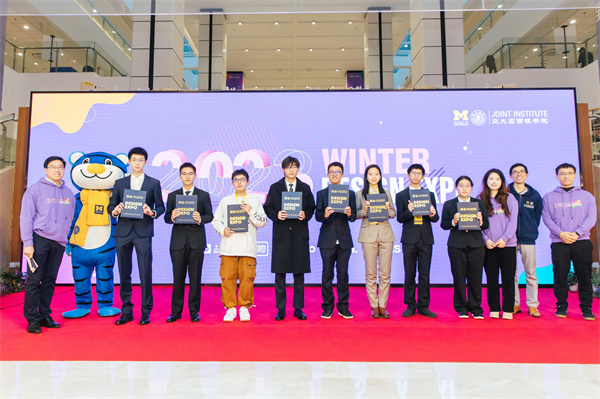
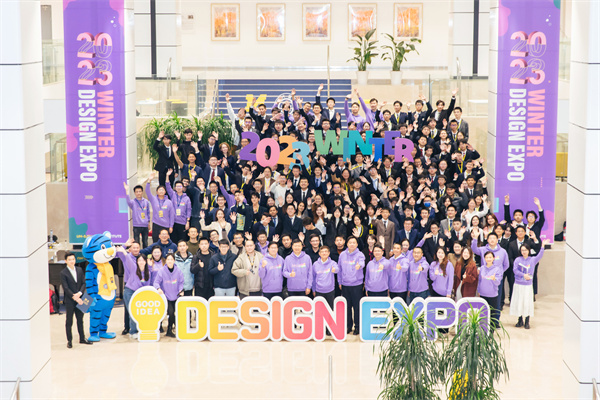
Onsite scenes of the design expo
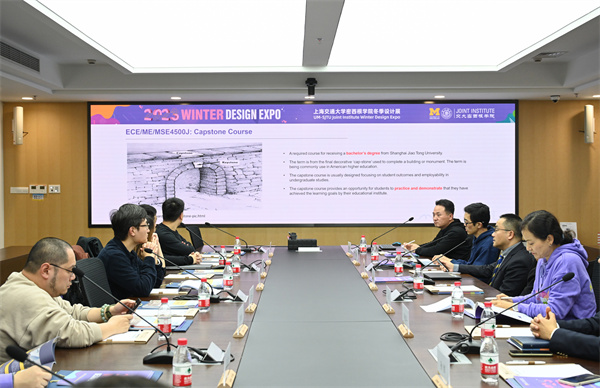
Representatives of JI and corporate sponsors have a meeting at Long Bin Building.
The JI graduation design projects have always emphasized the integration of industry, academia, and research. Since 2010, more and more enterprises have been providing and sponsoring “customized” projects aligned with their product’s market development direction. The proportion of collaborative graduation projects between JI and enterprises has been increasing, enhancing the effectiveness of engineering practical teaching through synergistic collaboration of university and industry resources. The design expo employs various effective methods like course introductions, visual displays, and dual mentorship with companies to stimulate students’ creative thinking from multiple perspectives. It offers a diverse platform for talent cultivation and corporate cooperation by the institute.






















